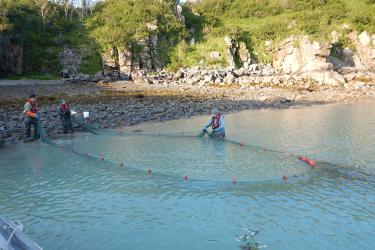What's Happening
This summer our scientists are hoping to prove what biologists have theorized for years – that newly hatched fish use Alaska deep-sea corals as a nursery ground to safely grow. Scientists on the East Coast have found compelling evidence that larval fish use coral to protect themselves from the elements and from prey. But it’s never been proven without a doubt in Alaskan waters.
Now, researchers Rachel Wilborn and Pamela Goddard hope to get clear answers in the Gulf of Alaska. Rachel designed and engineered a pump that can be lowered to the seafloor near coral gardens and take samples of fish larvae and plankton. If they find recently hatched fish, it would finally confirm that larvae in Alaska use coral as habitat. Being able to verify this would be a breakthrough because then scientists could potentially develop ways to increase larval fish survival rates by protecting their habitats. Doing so would result in continued sustainable fish populations and fisheries.
Pam and Rachel are also launching a new effort to modernize and increase the accuracy of fish and invertebrates that are taken as bycatch.
Both projects are being done while they and other scientists are conducting a bottom trawl survey of the Gulf. Our scientists have headed out to the Gulf every two or three years since 1984 to survey fish living on or near the seafloor. The data feed directly into managing sustainable fisheries and healthy ecosystems in the Gulf of Alaska.
Follow Rachel and Pam on their journey of discovery.
Meet the Bloggers

Rachel Wilborn is a NOAA Fisheries affiliated biologist with the Alaska Fisheries Science Center’s Resource Assessment and Conservation Engineering Division. Her research focuses on what lives at the bottom of the ocean, specifically sponges and corals, and their role as essential fish habitat. Rachel received a bachelor’s degree in oceanography from the University of Michigan and a master’s degree in biology from the University of West Florida.

Pam Goddard is a NOAA Fisheries affiliated biologist with the Alaska Fisheries Science Center’s Resource Assessment and Conservation Engineering Division. Her recent work has focused on benthic community structure and the role it plays in essential fish habitat. Pam has a bachelor’s degree in biology from Wheaton College, and a master’s degree in fisheries from the University of Washington.



